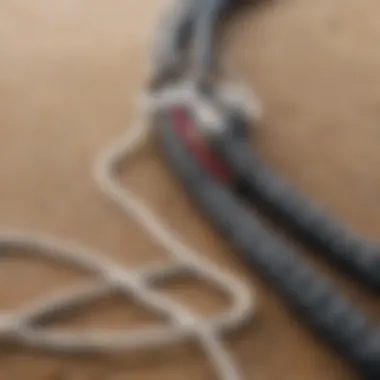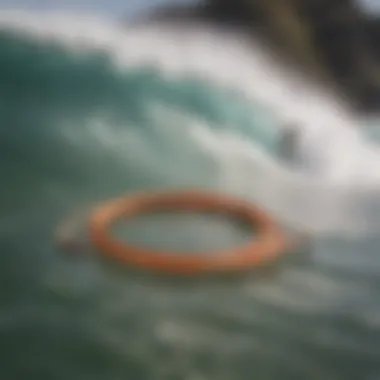Essential Insights on Surf Leash Sales and Selection


Intro
When talking about surfing gear, a common mistake is to overlook the surf leash. Yet, this essential piece of equipment plays a pivotal role in ensuring both safety and performance in the waves. The surf leash keeps your board attached to your ankle, preventing it from becoming a runaway projectile after a wipeout. However, during a surf leash sale, the real challenge lies in discerning quality from a mere bargain. With various options on the market, knowledge is your best ally.
This article aims to demystify the world of surf leash sales, identifying the types available, key factors to consider while purchasing, and market trends that are shaping buyer behavior. Whether you're a newbie angling for your first leash or an experienced surfer in the hunt for an upgrade, understanding what makes a quality surf leash could significantly enhance your surfing experience.
Gear Essentials
When you're gearing up for the surf, it's not just your board that takes the spotlight. The leash you choose is just as important. With this in mind, let’s delve into some essentials of surf leashes, from the top products to maintenance tips that can prolong their lifespan.
Top Picks for Surfing Equipment
With a plethora of options flooding the market, picking the right surf leash can be a tall order. Here are a few recommendations that stand out:
- Dakine Anemone Surf Leash: Known for its durability and comfort, this leash is perfect for everyday use.
- Creatures of Leisure Regular Leash: This one combines lightness with strength, making it ideal for various surf conditions.
- Ocean & Earth Ultralite Leash: If weight is a concern, this leash offers excellent performance without the bulk.
These choices, while varied, reflect only a fraction of what's available. It's important not to rush your selection, as investing in quality gear pays off in the long run.
Maintenance and Care Tips for Gear
Taking good care of your surf leash can help avoid frequent replacements. Here are a few tips to keep it in optimal condition:
- Rinse after use: Saltwater can weaken materials over time. Rinse your leash with fresh water after every session.
- Inspect regularly: Check for signs of wear and tear, particularly on the cord and cuff. Addressing small issues early prevents bigger problems later.
- Store properly: Avoid leaving your leash in direct sunlight for extended periods. Humidity can also be damaging, so try to store it in a cool, dry place.
"A well-cared-for leash can make the difference between enjoying your ride and a stressful session chasing down your board."
Equipped with these insights, both novice and seasoned surfers can better navigate surf leash sales. Next, we’ll explore some techniques and tips to enhance your surfing skills even further.
Understanding Surf Leashes
Understanding surf leashes is an integral part of any surfer's toolkit. While often taken for granted, this seemingly simple piece of equipment plays a vital role in ensuring not only the enjoyment of the sport but also safety and performance. Every surfer, whether a grommet or a seasoned wave rider, must grasp the nuances of surf leashes to make informed choices. With the right knowledge, a surfer can greatly improve their experience in the water, from maneuverability to the level of control.
Purpose and Functionality
Connection between surfer and board
The connection between surfer and board is one of the primary functions of the surf leash. It serves as a lifeline, keeping the board tethered to the surfer. This fundamental relationship allows surfers to retrieve their boards after wiping out – which can feel like having a parachute when jumping from a high plane. Having that board close by makes a big difference in those moments when a wave has just sent you tumbling.
- Key benefits:
- Prevents loss: Your board isn’t just a piece of foam; it’s your tool of the trade. Losing it could mean searching for it like searching for a needle in a haystack.
- Facilitates maneuverability: Surfers can make quicker transitions back to riding after a fall.
However, one must also be cautious. A leash that’s too long or too thin could be a pain—literally—especially if it wraps around your limbs during a wave crash.
Safety considerations
Safety considerations are paramount in surfing. A leash can help avoid hazards not only to the surfer but also to others in the water. For example, if a board gets loose during a gnarly swell, it can become a hazard. Having a reliable leash mitigates such risks.
- Key features:
- Strong materials: Leashes are often made from high-strength materials to resist breakage.
- Quick release: Some have mechanisms that allow quick disconnection—found to be useful if a surfer is stuck or tangled in challenging scenarios.
But, one must weigh the pros and cons. An overly sturdy leash might impair the surfer’s freedom of movement, leading to an awkward session instead of fluid maneuvers.
Impact on surfing performance
Impact on surfing performance is another essential aspect to consider. A leash that is poorly designed or unsuitable for the surf conditions can detract significantly from a surfer's experience. Think of it like driving with faulty brakes; it simply won’t work out well.
- Influences on performance:
- Weight and drag: A cumbersome leash can add unnecessary weight which hampers agility. The drag it creates can hold back surfers from quite smoothly slicing through waves.
- Flexibility and responsiveness: A good leash allows the surfer to respond quickly to changing wave conditions.
Some leashes may indeed offer more flex, enhancing responsiveness. On the flip side, an ultra-flexible leash might not provide the durability needed for aggressive surfing conditions, creating a dilemma of choice.
Basic Components
Strap design
The strap design of a surf leash plays a significant role in comfort and adjustability. Comfort is key; after all, that strap may be hugging your ankle for hours while you're tearing it up in the surf.
- Key characteristics:
- Padding: More cushioned straps feel better to wear and don’t cause chafing.
- Adjustability: Some straps come with Velcro adjustments to make them snug without pinching.
That said, too much padding can also lead to overheating or being cumbersome, especially in warmer waters—there’s a balance to find.
Cord material and thickness


Cord material and thickness are crucial for a leash's effectiveness and durability. Often made from urethane, the thickness of the cord should be matched to the type of surfing one intends to do.
- Benefits of thick cords:
- Durability: Thicker cords generally withstand more strain, providing reliability in heavy surf.
- Less chance of snapping during use: A bigger, badder cord may be just what’s needed for intense waves.
Yet, thicker generally means less flexibility, which might seem overly rigid for smaller, mellow surf days.
Swivels and rails
Swivels and rails provide additional functionality to surf leashes. They help manage the cord and prevent tangling, which can be a real nuisance in the thick of a session.
- Key features:
- Rotational capability: A good swivel allows the leash to rotate freely, preventing any tangling when a surfer twists and turns.
- Robustness: Specific construction allows for both flexibility and strength.
However, overly complex mechanisms can fail, leaving surfers in the lurch. A savvy surfer knows that simplicity often leads to reliability.
"Choosing the right surf leash is more than just a preference; it’s about safety and enjoying every single wave without hassle."
Types of Surf Leashes
Understanding the different types of surf leashes is crucial when navigating the sale landscape. Each category serves a unique purpose, influencing performance, safety, and flexibility on the waves. It's akin to understanding the varying styles of boats if you're an avid sailor. Just as you wouldn't use a yacht to navigate a river, matching the leash to your surf style and conditions can augment your overall experience.
Standard Leashes
Length variations
Length variations in standard leashes are paramount when it comes to tailoring your surf gear to your needs. Generally, standard leashes range from about six to ten feet, and selecting the right length can significantly impact your ride. Shorter leashes may offer less drag while paddling and allow for quicker turns, making them a popular choice among agile surfers, like those slicing through smaller waves.
However, the unique characteristic of longer leashes is their ability to keep you connected with your board even when caught in tumultuous conditions. It’s like having a security tether—you’re less likely to lose your board in the surf, especially when the waves start to grow. But be careful; longer leashes can increase the risks of tangling or dragging in rough surf, which could lead to accidents.
Appropriate for different surf conditions
The appropriateness of standard leashes varies drastically with different surf conditions. Local surf shops often recommend matching the leash to the size and strength of the waves you'll be surfing. For instance, in mellow surf, a standard leash around six feet may suffice, providing enough slack to maintain connection without excess drag.
Conversely, when hitting more powerful waves, opting for a longer and thicker leash—often around eight to ten feet—becomes essential as it ensures that you’re anchored securely to your board. This choice is especially advantageous in crowded surf spots where losing your board could hurt not only yourself but others around you.
Premium Leashes
Features of high-end models
When it comes to premium leashes, they often boast an array of features that can elevate a surfer's experience. These leashes are built with higher-grade materials, showcasing robust construction, which offers enhanced durability, critical for those who frequently tackle challenging surf conditions. They might include double swivels, reinforced connections, and even shock-absorbing capabilities that cushion against sudden tugs.
The key characteristic of these leashes is their reliability. Surfers investing in high-end models often find that they last longer and perform better than their standard counterparts. However, it's essential to weigh these benefits against the steeper price tag. For hardcore surfers, the investment can pay off, ensuring you won’t find yourself sans board in the middle of a challenging set.
Investment versus durability
The investment versus durability conversation is particularly pertinent when discussing premium leashes. A higher upfront cost typically signifies superior craftsmanship and materials, designed to withstand the rigors of intense surf sessions. This is a compelling argument for purchasing a quality leash, especially if you're surfing regularly.
On the flip side, cheaper leashes may serve new surfers well for initial use, but they might need replacing sooner than expected. This reality can lead to spending more money in the long run than if one had opted for a pricier, yet durable leash from the get-go. Therefore, considering longevity and performance at the time of purchase could save a surfer a world of hassle down the pipeline.
Specialized Leashes
Leashes for big wave surfing
Leashes for big wave surfing are an arena of their own, tailored specifically for extreme conditions. These leashes are made with heavier materials and feature robust designs designed to handle the immense forces exerted by massive waves. The resilience of these leashes enables surfers to remain tethered to their boards amidst the chaos of large surf.
One key characteristic of big wave leashes is their thickness. Generally, you’ll find these leashes are around nine to ten millimeters thick, providing that extra layer of safety. They offer security during wipeouts, which can be frequent and perilous in such conditions. The downside, however, is that it can lead to higher drag in less powerful waves.
Longboard versus shortboard use
Lastly, when it comes to the distinction between longboard and shortboard use, it's critical to select a leash that complements your board style. Longboard surfers typically prefer longer leashes, often around eight or nine feet, to accommodate their wider turns and slower pace. This choice helps to create space and avoids unnecessary strain while riding.
In contrast, shortboard surfers benefit from shorter leashes, which allow for tighter wave riding and quicker movements. The unique balance in this choice lies in ensuring enough length to prevent disconnection without creating excess drag. Understanding the differences between these leash styles and their appropriate applications can make or break a surfing experience, highlighting the importance of deliberate purchasing decisions.
Evaluating Quality in Surf Leashes
Evaluating the quality in surf leashes is crucial in this article, as it can significantly impact both safety and overall performance while surfing. The key components of a surf leash may seem trivial but are central to providing a secure attachment between the surfer and the board. Understanding the interplay between materials, craftsmanship, and brand reputation allows surfers to make informed choices, ultimately enhancing their enjoyment and safety on the waves.
Materials Matter
Types of cords and their benefits
Cords come in various types, each tailored to deliver specific benefits for different surfing scenarios. Common types include polyurethane and nylon. Polyurethane cords are valued for their elasticity and durability. Surfers often prefer them due to their ability to stretch and absorb shock during wipeouts, reducing the risk of injury. Conversely, nylon cords, while slightly less elastic, boast excellent resistance to abrasions, making them suitable for rocky surf spots.
The unique feature of polyurethane, its superior shock absorption, is what attracts many surfers, especially those adventurous enough to tackle heavy waves. However, a downside could be that while they offer great strength, they might wear out quicker than nylon, especially in harsh conditions. Knowing the advantages and disadvantages of these materials is crucial for making an informed decision when purchasing a surf leash.
Analysis of strap materials


The straps of surf leashes receive just as much attention as the cords. Most often, they are made from neoprene or polyester. Neoprene is typically praised for its comfort and flexibility, reducing irritation to the ankle or calf during long sessions in the water. Polyester, on the other hand, is celebrated for its strength and durability. It exhibits low stretch, providing a more stable connection to the board.
A distinctive feature of neoprene straps is their cushioning effect, allowing for a better feel and comfort when worn. However, they may not perform as well under stringent conditions. On the contrary, polyester straps are robust but can lack that softer feel. Evaluating these materials is necessary to ensure that the surfer’s experience remains positive over prolonged use.
Manufacturing Process
Importance of craftsmanship
The craftsmanship of surf leashes plays a huge role in determining their quality. Attention to detail during manufacturing can make all the difference, affecting everything from the stitching to the finishing touches. High-quality craftsmanship ensures that leashes perform as intended and can resist the vigorous conditions of ocean surfing.
Investing in well-crafted leashes means reduced risk of breakage and better performance overall. This is especially notable when surfing in challenging environments, as subpar craftsmanship can lead to catastrophic failures when least expected. The unique feature of meticulous stitching proves to be a selling point, as reinforced areas are less likely to give under stress. Well-made leashes stand the test of time, contributing significantly to their value.
Reputation of manufacturers
Manufacturers' reputation serves as a vital marker for quality in the surf leash market. Brands that are well-regarded typically have a history of producing durable and reliable products. When surfers choose a leash from a reputable manufacturer, they are often guaranteed quality assurance grounded in consistent performance.
Well-known brands tend to back their products with warranties that reflect their confidence in their craftsmanship. A business with a solid reputation often signals a commitment to quality over cost-cutting, which is significant in the surfing community. On the flip side, lesser-known brands may offer cheaper alternatives, but they often may not provide comparable safety or longevity. Thus, knowing the reputation of a manufacturer provides confidence and peace of mind when making a purchase.
"In the world of surfing, a reliable leash is like the unsung hero, always holding your board safe and sound, while you chase the ultimate wave."
Overall, the evaluation of quality in surf leashes encompasses a blend of materials, craftsmanship, and brand reliability. Surfers should gauge these elements to ensure they invest in a leash that will enhance their surfing experience, ensuring safety and performance are never compromised.
The Surf Leash Sale Landscape
In the competitive world of surfing, understanding the nuances of the surf leash sale landscape is not just an afterthought—it's essential. The surf leash, often overshadowed by boards and wetsuits, plays a pivotal role in the surfing experience. Knowing when and where to snag a quality leash can make all the difference. Exploring market trends and timing strategies can help surfers make informed decisions, ensuring they get the best gear for their needs. When it comes to prepping for waves, a well-timed purchase can be as crucial as knowing the local tides.
Market Trends
Growth of e-commerce
The rise of e-commerce has significantly changed how surfers shop for gear, including leashes. The convenience of shopping online means that you can peruse a wider selection with just a few clicks, right from the comfort of your sofa. Many surf brands now offer exclusive online sales that you simply won’t find in-store. This shift allows surfers to compare prices, read reviews, and even get recommendations—all at their leisure.
However, it’s worth noting that while online shopping offers convenience, it also comes with its quirks. The inability to physically inspect a leash can sometimes pose challenges. Getting it wrong could mean dealing with returns, which is never a fun prospect when all you want is to hit the waves.
Brand collaborations
Brand collaborations have been popping up more frequently in the surf industry, and they can greatly enhance the offerings available during leash sales. When two brands come together, often, the result is a hybrid product that combines the best features from both. This means surfers can sometimes snag cutting-edge designs or features at what feels like a bargain.
On the flip side, collaborations can also lead to limited edition products that fly off the shelves. Miss out on the launch, and you might be hunting on resale sites at inflated prices. Knowing when these collaborations drop is therefore crucial for smart shopping.
Sale Timing and Promotions
Seasonal discounts
Being aware of the seasonal discounts can provide surfers a significant edge in obtaining gear without breaking the bank. Many shops mark down leashes during off-peak seasons, particularly in late summer or late winter when surfers are less likely to make new purchases. This can be the ideal time to upgrade or replace that older leash you've been using.
The catch with seasonal discounts is that they often come with a limited selection. So, if you’ve got your eye on a specific brand or type, waiting for the sale might mean missing out altogether on what you really want.
Special events and promotions
Special events such as surf festivals and competitions often lead to exclusive promotions. Retailers might offer sales to coincide with these occasions, enticing fans and participants alike. This is a good opportunity to explore different brands, as many set up pop-up shops or booths showcasing their latest products.
However, it’s important to be cautious during these times. While the allure of festival discounts is tempting, some promotions might not always reflect genuine value. Doing your homework prior to the event can help you discern which deals are worth pursuing and which ones are just fluff.
Understanding the surf leash sale landscape arms surfers with the knowledge needed to make savvy purchases. Awareness of trends, timing, and promotional strategies is what sets informed surfers apart from the rest.
By staying clued into these aspects of the market, surfers can ensure they’re getting not just a leash, but the right leash for their adventures on the water. Whether you're a rookie or a seasoned wave-rider, this insight can elevate your surfing experience.
Purchasing Strategies for Surf Leashes
When it comes to snagging the right surf leash, having a clear purchasing strategy can make all the difference. As we delve into this section, we’ll explore not just where to buy, but also how to evaluate your options for getting the best bang for your buck. The goal is to empower both seasoned surfers and newbies alike to feel confident in their decisions.
Where to Buy
Online versus local surf shops
Where you choose to buy your surf leash can significantly influence your overall satisfaction. Online shopping offers the convenience of browsing a vast selection from the comfort of your couch. Retailers, such as Amazon or specialized surf gear sites, often run sales or have clear comparison features. On the flip side, visiting local surf shops provides a tactile experience. You can inspect the leash firsthand, ask knowledgeable shop owners for advice, and even try it on a surfboard. While both avenues have their perks, the key is understanding your own preferences—are you a click-and-go shopper or someone who enjoys getting their hands dirty?
The right place to buy can sometimes be the difference between a decent surf day and a total wipeout.
Evaluating retailer reputations
Before you commit your hard-earned cash, it’s vital to know who you're buying from. Evaluating retailer reputations helps ensure you’re not just chasing the next flashy sale or discount. Key factors to consider include customer service ratings, return policies, and reviews. Websites like Reddit and various surfing forums offer forums to discuss experiences with different retailers.
A unique feature of checking retailer reputations is tapping into the feedback from other surfers. This community-driven insight can alert you to potential red flags or point you toward hidden gems. For instance, a popular local shop may provide personalized service but might lack the robust online inventory found elsewhere. Weighing these aspects can help weed out unreliable sources.
Maximizing Value


In a world saturated with options, understanding how to maximize your value is crucial. This section discusses ways to ensure you’re not just paying for a leash, but that you’re truly investing in your surfing experience.
Assessing sale conditions
When hunting for deals, assessing sale conditions is paramount. Not all sales are created equal, and often, discounts might hide underlying issues—be it outdated styles or inferior stock. Keep an eye on the specifics of each promotion. For example, a surf leash on clearance because it’s last season’s model may not serve you well when you hit the waves this year.
One big advantage of understanding these conditions is that it allows you to spot genuine bargains from the typical hype. During major shopping events like Black Friday, knowing which brands hold their value can help you discern between a worthwhile investment and a mere flash-in-the-pan offer.
Understanding warranty options
Another key aspect of maximizing your value is understanding warranty options offered at the point of sale. Many surf leashes, especially the pricier ones, come with warranties that protect your investment. Absorbing the details of these warranties can be a game-changer. A product that might seem costly upfront could prove to be a smart buy if it’s backed by a solid warranty policy.
Not all warranties are created equal. Some cover manufacturing defects, while others might include breakage from regular use. Sliding this knowledge into your decision-making process ensures you pick gear that’s supported by the retailer in times of need, providing peace of mind as you carve through the surf.
Maintaining and Caring for Surf Leashes
Proper maintenance and care play a crucial role in extending the life of surf leashes, which, despite being a rather unassuming piece of equipment, are fundamental to a safe and enjoyable surfing experience. Neglecting them can lead to unexpected failures at sea, which can be risky. By giving your leash the attention it deserves, you not only protect your investment but also ensure that your time on the water is as smooth as possible. In this section, we will explore routine maintenance tips and signs of wear that help surfers keep their gear in peak condition.
Routine Maintenance Tips
Cleaning methods
Cleansing your surf leash is not just a matter of aesthetic; it's essential to remove the salty residue and sand that accumulates after a day's ocean frolicking. A simple rinse with fresh water can do wonders. Just dunk it in a bucket or spray it down with a hose. The goal is to remove any potentially damaging particles.
The key characteristic of this cleaning method is its simplicity and effectiveness; it requires no special tools or techniques. A popular choice among surfers, it offers decided benefits since neglecting this could lead to corrosion or degradation of materials over time.
A unique feature of these cleaning methods is that they can easily be integrated into your regular post-surf routine. However, often folks forget about cleaning the leash, making this a step that shouldn't be skipped. If it becomes grimy, the leash can start to degrade quicker than you might realize.
Storage recommendations
Storing your surf leash properly is another aspect that enhances longevity. It’s advisable to hang or lay it flat instead of coiling it tightly. Tight coils can lead to kinks or stress on the material, which is counterproductive.
The critical characteristic here is preventing unwanted wear and tear. Storing a leash out of direct sunlight is also a wise move, as UV rays can wreak havoc on materials over time. It ensures the leash remains durable and ready for your next session.
The unique feature of storage recommendations is how it encourages thoughtful usage of gear. It may seem trivial, but by taking this step, surfers can enjoy longer-lasting relationships with their gear. If you avoid proper storage, though, you might find yourself needing a new leash sooner than intended.
Signs of Wear and When to Replace
Being able to identify when your surf leash is starting to fail is paramount for any surfer. Ignoring small issues can escalate into bigger ones if left unchecked.
Identifying damage
Identifying damage means examining the leash regularly for signs of wear, such as frays in the cord or cracks in the swivel. It’s not just about visual inspection; it also involves a touch test—run your fingers along it to feel for any irregularities.
The key characteristic of this aspect is the proactive approach it encourages. By being vigilant, you’re not only prolonging the lifespan of the leash but also safeguarding your own well-being in the water.
The unique feature of identifying damage is that it's straightforward yet often overlooked by many surfers. Fail to catch a crack, and you might just find yourself chasing after your board in choppy waters, which is far from an ideal experience.
Impact on safety and performance
The impact on safety and performance is a point that deserves serious consideration; a worn leash can lead to disastrous situations. If the leash fails, not only do you risk losing your board, but you also compromise your safety.
The defining characteristic here is understanding that your leash is a lifeline—not just a piece of gear. Relying on an unreliable leash can disrupt your focus, which is not ideal when you catch that perfect wave.
A unique feature of this awareness is how it ties together both safety and performance, enhancing the overall surfing experience. It also fosters a deeper respect for one’s equipment, as the relationship between a surfer and their gear goes beyond utility. Ensure you're regularly replacing worn gear, and you'll find your time on the water much more enjoyable.
"A good surf leash is to a surfer what a dependable partner is in life—essential and dependable."
Keeping your surf leash in shape involves regular cleaning, mindful storage, and a keen eye for damage. All these practices collectively contribute to enhancing your surfing experience, ensuring that every ride is exhilarating rather than stressful.
Final Thoughts on Surf Leash Sales
As we ride the wave of information regarding surf leashes, it becomes abundantly clear that making informed choices is the crux of any successful purchase. The world of surf leashes is not just about picking a piece of cord; it's a blend of understanding the nuances—quality, safety, functionality—and knowing which factors align with your surfing style and intended use. In the context of surf leash sales, a well-informed surfer is not just prepared to shop; they are primed to elevate their surfing experience.
The Importance of Informed Choices
When it comes to surf leashes, the choices made on the market can significantly impact one's overall enjoyment and safety in the water.
Balancing cost versus quality
Navigating the thin line between cost and quality serves as a pivotal element in this discussion. Many riders can find themselves drawn towards cheaper leashes, especially during sales, but it's crucial to ask—does a lower price tag mean compromised safety? Quality leashes often utilize better materials like urethane for the cord and neoprene for the strap, which can withstand the challenges of ocean conditions far better than their budget-friendly counterparts. This balance is beneficial as it encourages surfers to educate themselves about the longevity and reliability of their gear, further reinforcing the idea that investing a little more can save you a lot of headaches down the road.
The unique angle here is the potential for serious repercussions. A high-quality leash may cost more upfront, but a failure in a critical moment could lead not only to lost gear but serious safety risks. Hence, a savvy surfer understands that this pursuit of quality is not merely a personal choice; it’s integral to enjoying the surf communty safely.
Long-term value in choices
The long-term value of purchasing the right surf leash transcends financial considerations. This aspect speaks to the durability, performance, and adaptability of the leash through different conditions and over time. When a surfer invests in a leash that is not only robust but also suits various surf styles—be it big waves or gentle swells—they're setting themselves up for a much richer surf journey.
A notable characteristic here is the misconception that inexpensive gear might suffice for beginners. While that might hold some truth initially, there comes a time when a quality leash ensures that each session on the water can be both thrilling and safe, allowing one to push their limits without the worry of equipment failure. The additional benefit? A reliable leash will often stay with its owner for multiple seasons, translating to less environmental waste and a more sustainable practice.
In considering long-term value, think about those heart-pounding moments in the water. A sturdy leash that you can rely on to keep you tethered to your board is invaluable. It isn’t just about money spent; it’s about countless waves caught over a lifetime of surfing.
Remember: Choosing wisely now impacts not just your wallet but also your overall relationship with this sport. Making informed decisions today paves the way for years of thrilling adventures on the waves.
Ultimately, as we wrap up our thoughts on surf leash sales, the emphasis continuously circles back to the significance of making choices rooted in knowledge and understanding, ensuring every surfer’s experience is as rich and fulfilling as the sport itself.



